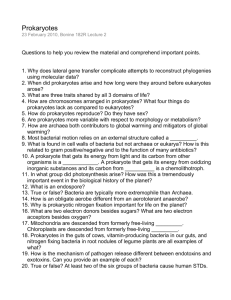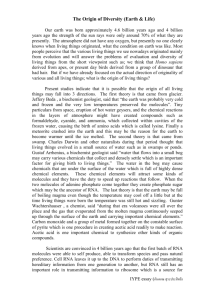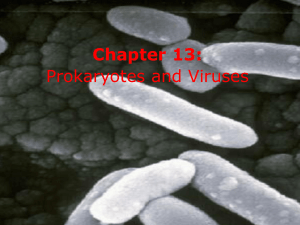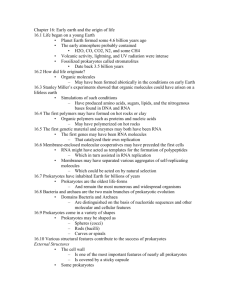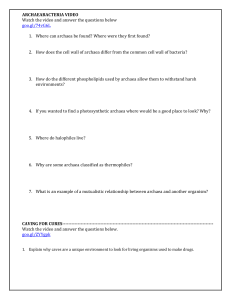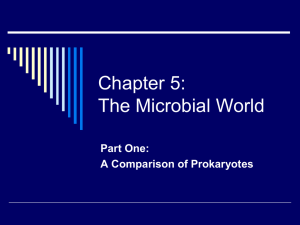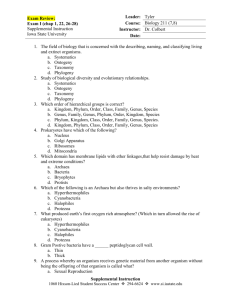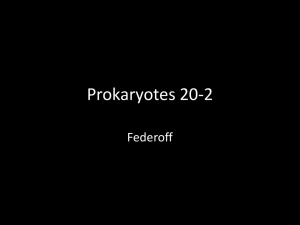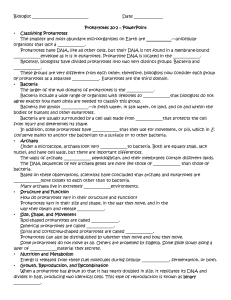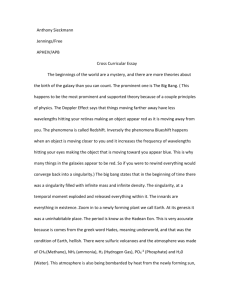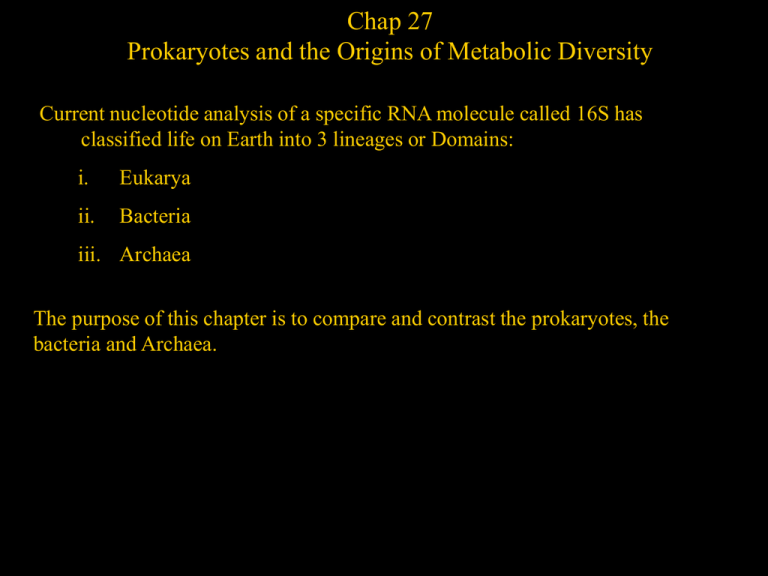
Chap 27
Prokaryotes and the Origins of Metabolic Diversity
Current nucleotide analysis of a specific RNA molecule called 16S has
classified life on Earth into 3 lineages or Domains:
i.
Eukarya
ii.
Bacteria
iii. Archaea
The purpose of this chapter is to compare and contrast the prokaryotes, the
bacteria and Archaea.
1
Figure 27.2 The three domains of life
2
Major Groups of Prokaryotes
Spirochetes
Extreme
Methanogens
Thermophiles
Extreme
Halophiles
Proteobacteria
Cyanobacteria
Bacteria
Archaea
Universal Ancestor
3
Domain Archaea
Structural Differences
•
Cell Wall
• A:
only protein
• B:
peptidoglycans
Gram positive and gram negative: stain acts on the
peptidoglycans and gram positive bacteria have more
peptidoglycans so pick up more stain.
• E:
plants have polysaccharides; animals have no cell walls and
fungi have chitin
4
Figure 27.5x Gram-positive and gram-negative bacteria
5
Figure 27.5 Gram-positive and gram-negative bacteria
6
•
Cell Membrane
• B & E: straight chain fatty acids connected to glycerol
• A: HC’s linked to glycerol molecules (no fatty acids)
Molecular Biology Comparisons
•
Organization of the genome
• similar to bacteria
• chromosome is a single piece of circular DNA
• plasmids are present
• thermal denaturation resistance: provided by the presence of a high
salt concentration and DNA binding proteins
7
•
DNA Replication
• DNA polymerases resemble eukaryotic polymerases in their
primary protein sequence.
• some proofreading that occurs during replication
• topoisomerases and restriction restriction enzymes are present.
•
Transcription
• RNA polymerase is more closely related to euk. polymerase in
terms of genes. There are several kinds of RNA polymerases and
therefore several genes.
• E. coli RNA polymerase (bacterial) can initiate transcription
whereas the archaea RNA polymerase cannot when in vitro
(transcription factors are needed.)
• Archaea promoter regions are rich in A’s and T’s like the TATA box
of eukaryotes.
8
•
Gene Organization
• Introns have been found in rRNA and tRNA genes of archeal
genomes.
• functionally related genes are often organized in operon-like
structures.
Reproduction
•
Prokaryotes reproduce asexually by binary fission
•
Neither mitosis nor meiosis occurs (as it does sin eukaryotes)
• Three Mechanisms of Gene Transfer (not sexual)
•
1.
Transformation
2.
Conjugation: direct transfer by sex pili
3.
Transduction: viral transfer from one prokaryote to another.
Endospores: resistant cells that can withstand most high heat.
9
Figure 27.x1 Prokaryotic conjugation
10
Table 27.2 A Comparison of the Three Domains of Life
11
Archaea Diversity
Extremophiles: a general term to describe the “extreme” environments in
which the archaea inhabit
•
Methanogens
• methane or marsh gas is produced
• CO2 + H2 produces CH4 + H2O
• they hate oxygen
• strict anaerobes
• they are decomposers at sewage plants, inhabit the guts of
herbivores (cattle), termites.
12
•
Extreme Halophiles
• Great Lake, Dead Sea
• Some tolerate the high salt, others require it.
• They photosynthesize using a pigment called bacteriorhodopsin.
•
Extreme Thermophiles
• most enjoy the warm of a 60 – 80o C environment
• some will obtain energy from sulfur compounds
• hot springs and thermal vents
13
Figure 27.10 An anthrax endospore
14
Evolution of Photosynthesis
Very first prokaryotes were heterotrophs. That is, they required an organic
compound such as glucose to make energy.
•
Photoheterotrophs: obtain carbon from some organic compound but
make ATP with the help of light.
•
Chemoheterotroph: breakdown organic compounds for ATP and to
obtain their carbon. Most widely for of nutrition in prokaryotes
Glycolysis was probably the first metabolic pathway used to make ATP.
•
The fact that almost every modern organism has this pathway supports
the idea that glycolysis was one of the earliest pathways to make
ATP.
15
What selection pressure would have begun to favor some sort of organism that
could make its own energy?
•
The ability to make their own food required the:
• harnessing of the sun to make ATP
• creation of reducing power too convert CO2 into organic cpds.
16
Evidence the PS evolved early on
1.
Many different prokaryotes possess this ability. The researches think
because of the complexity of PS, that it developed in a common
ancestor.
2.
PS may have been present and then lost in organisms related to those
that still are photosynthetic.
3.
Cyanobacteria
•
These are the only autotrophic prokaryotes that release oxygen
with the splitting of water.
•
Cyanobacteria have been shown to be a major part of
environment when oxygen was present
•
Fossils of prokaryotes, some 3.5 billion years old, look like
modern cyanobacteria
17
Evidence the PS evolved early on
4.
5.
The complexity of PS
•
Recall that it requires two photosystems
•
Some prokaryotes use a single photosytem involving hydrogen
sulfide. The H2S gets split instead of water.
The evolution of cyanobacteria with their oxygen production changed
the entire environment from a reducing one to an oxidizing one.
•
The use of oxygen in respiration increases the efficiency of
breaking down fats and carbos.
•
Electron transport chains and proton gradient mechanisms as well
as ATP synthesis proteins are thought to have evolved from PS
machinery.
18
Table 27.1 Major Nutritional Modes
19

